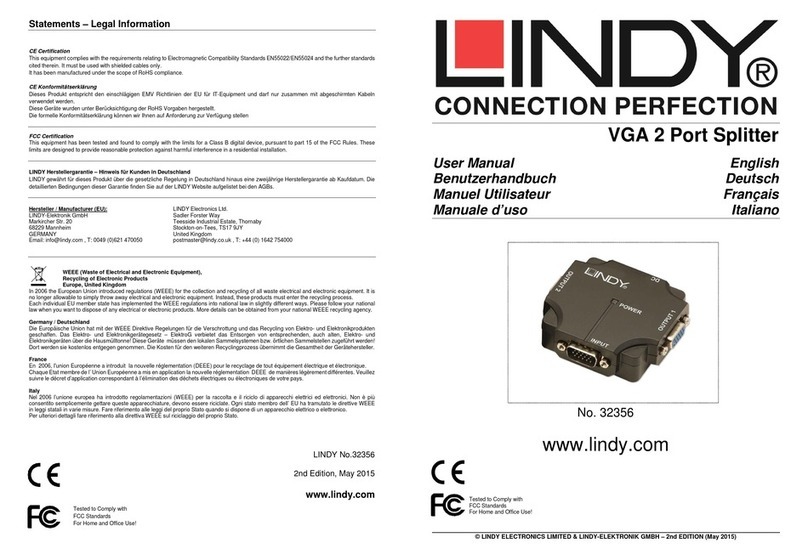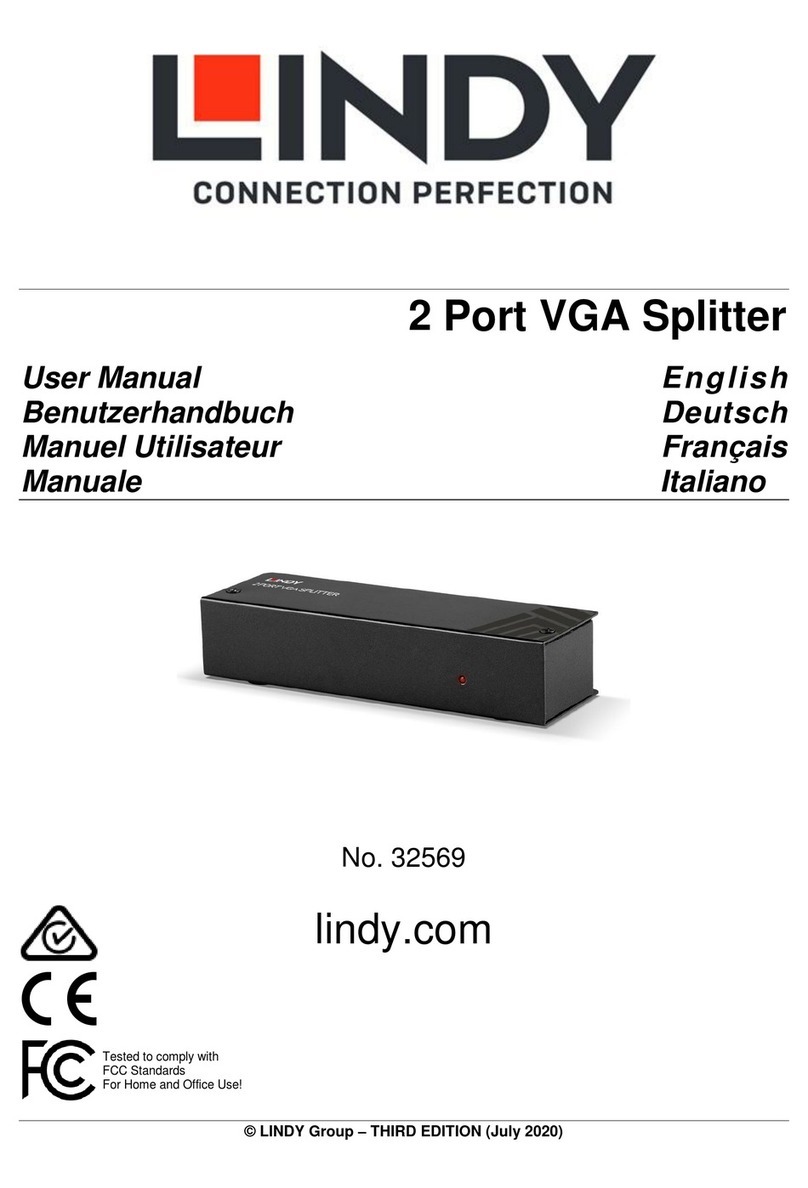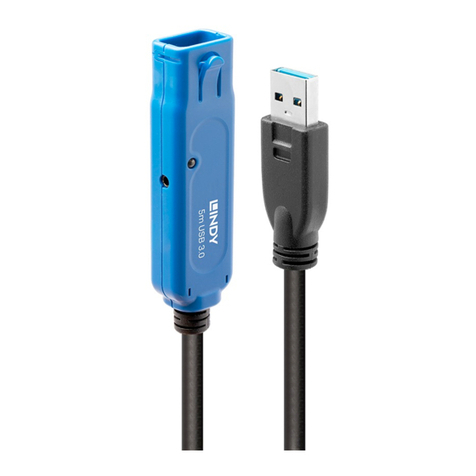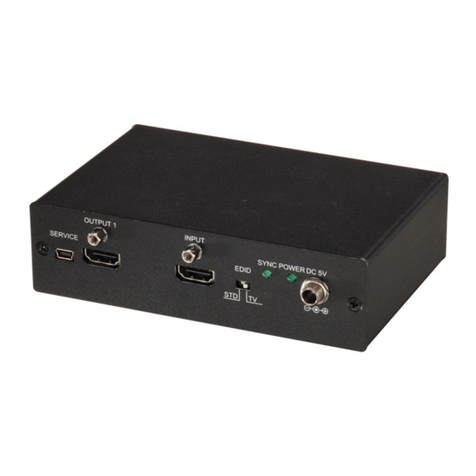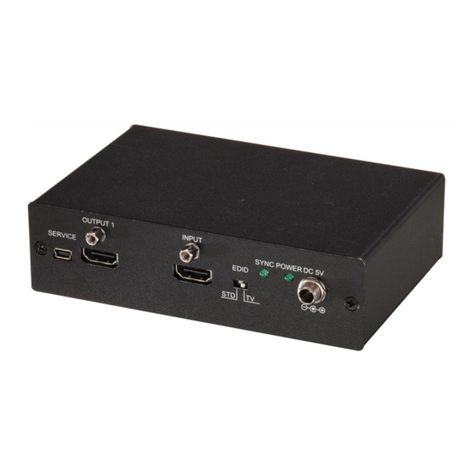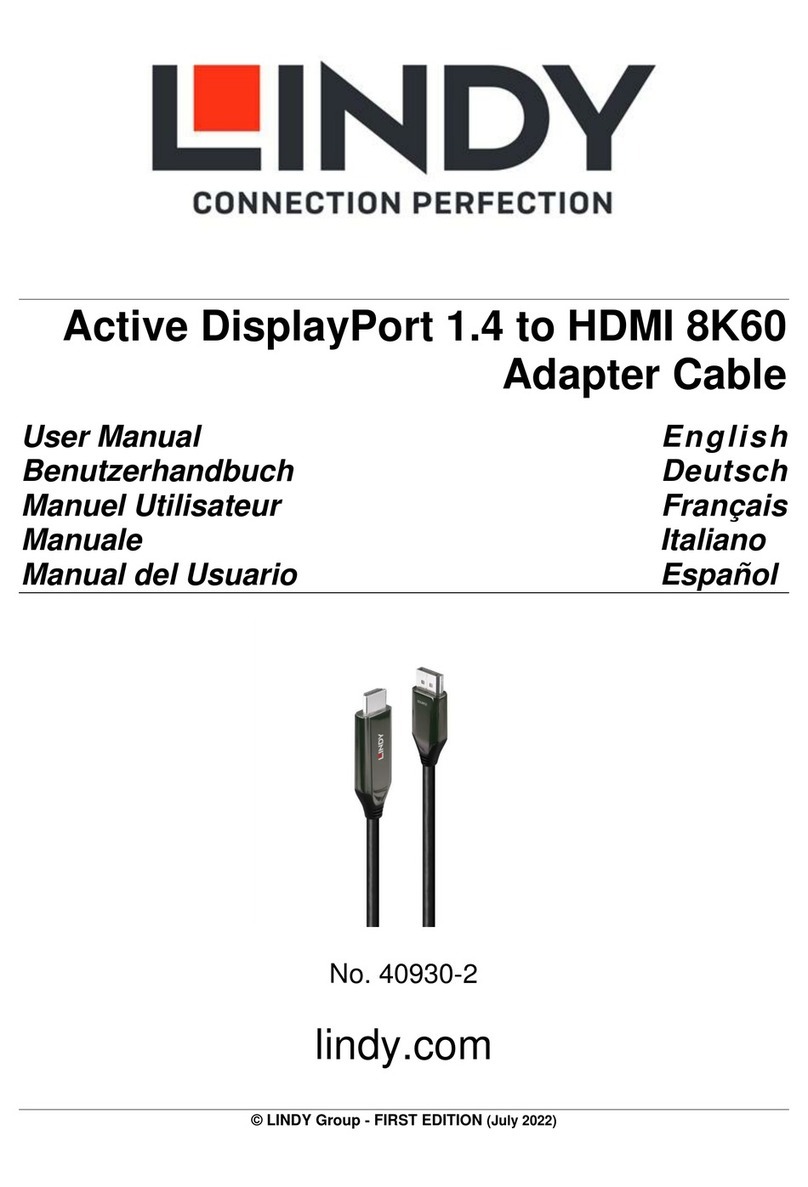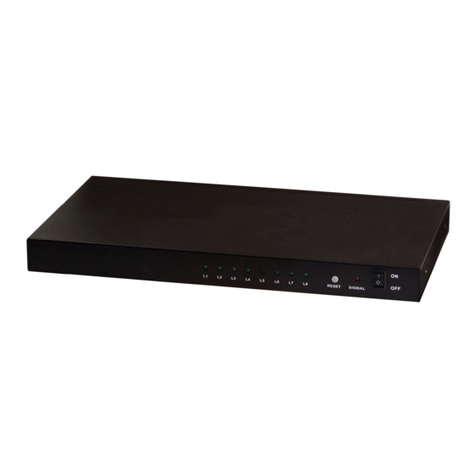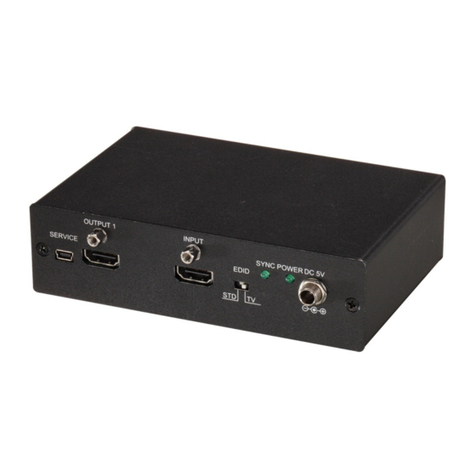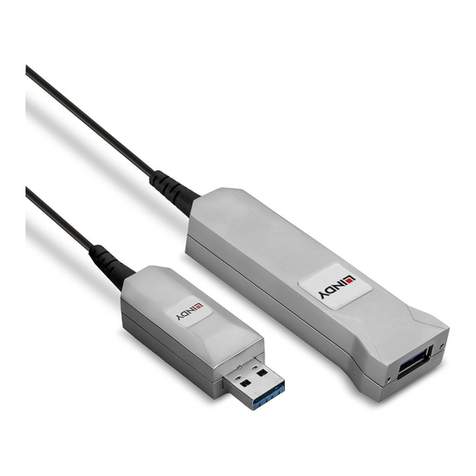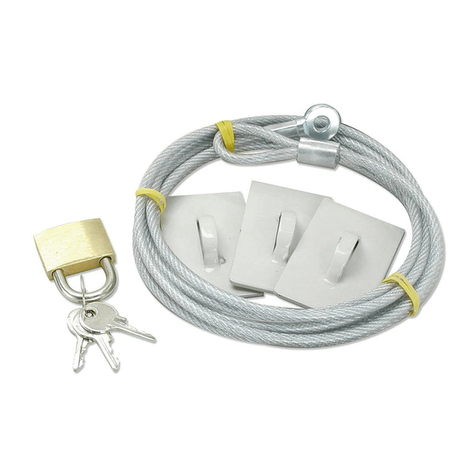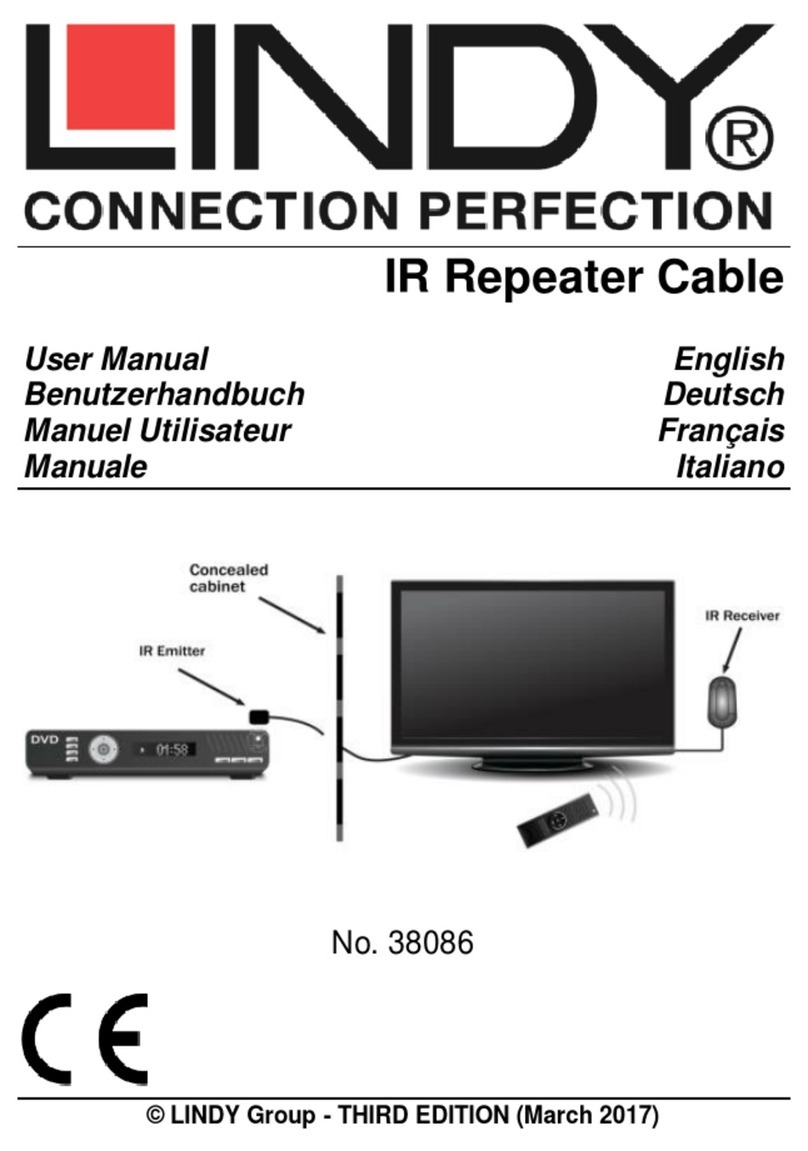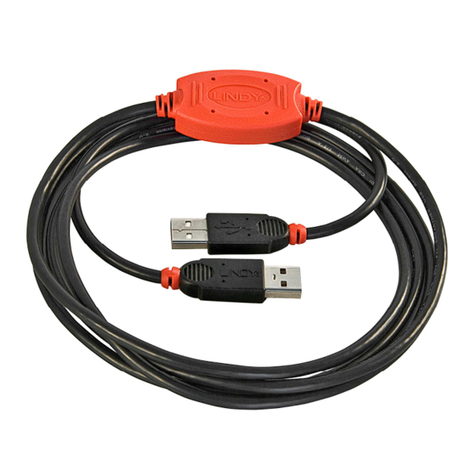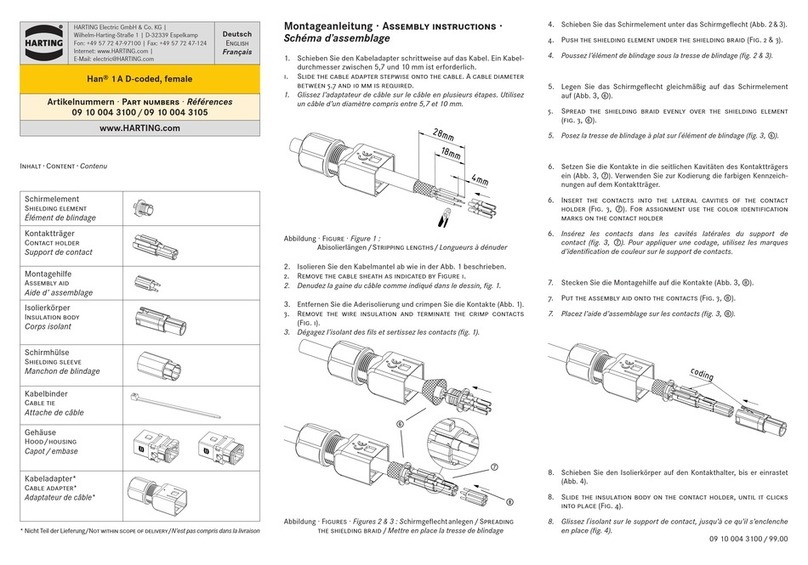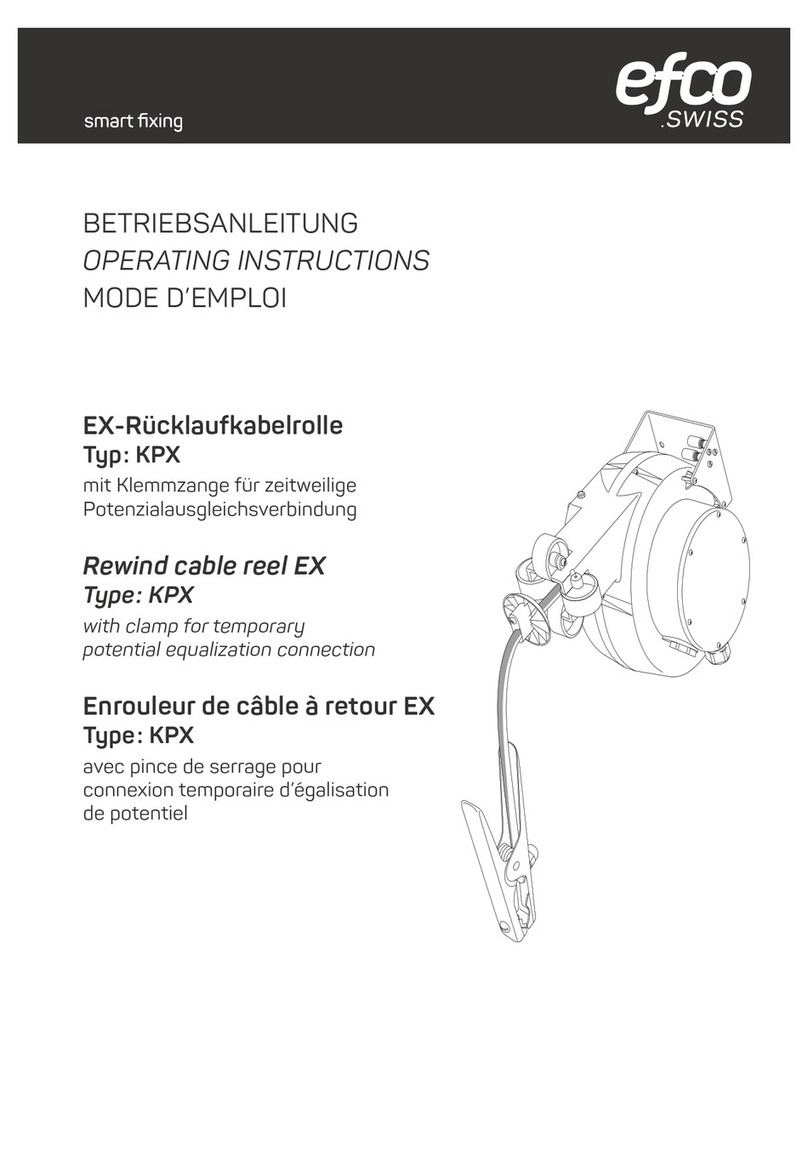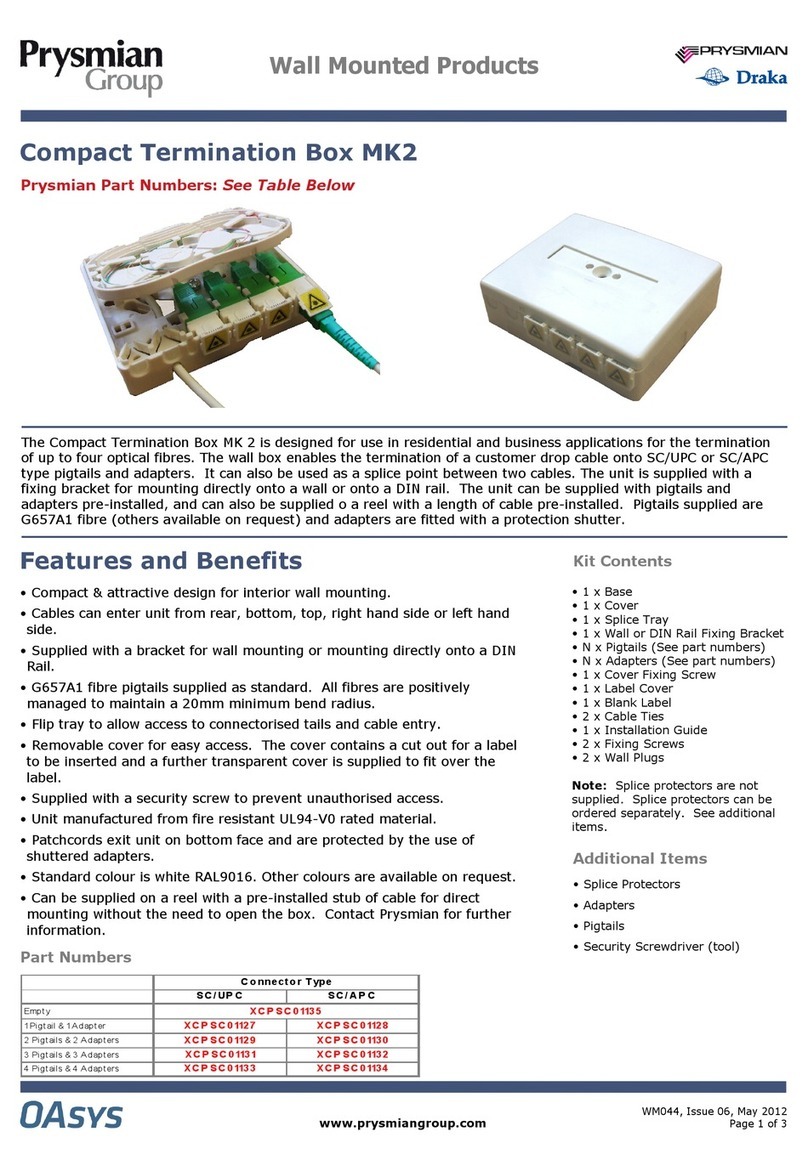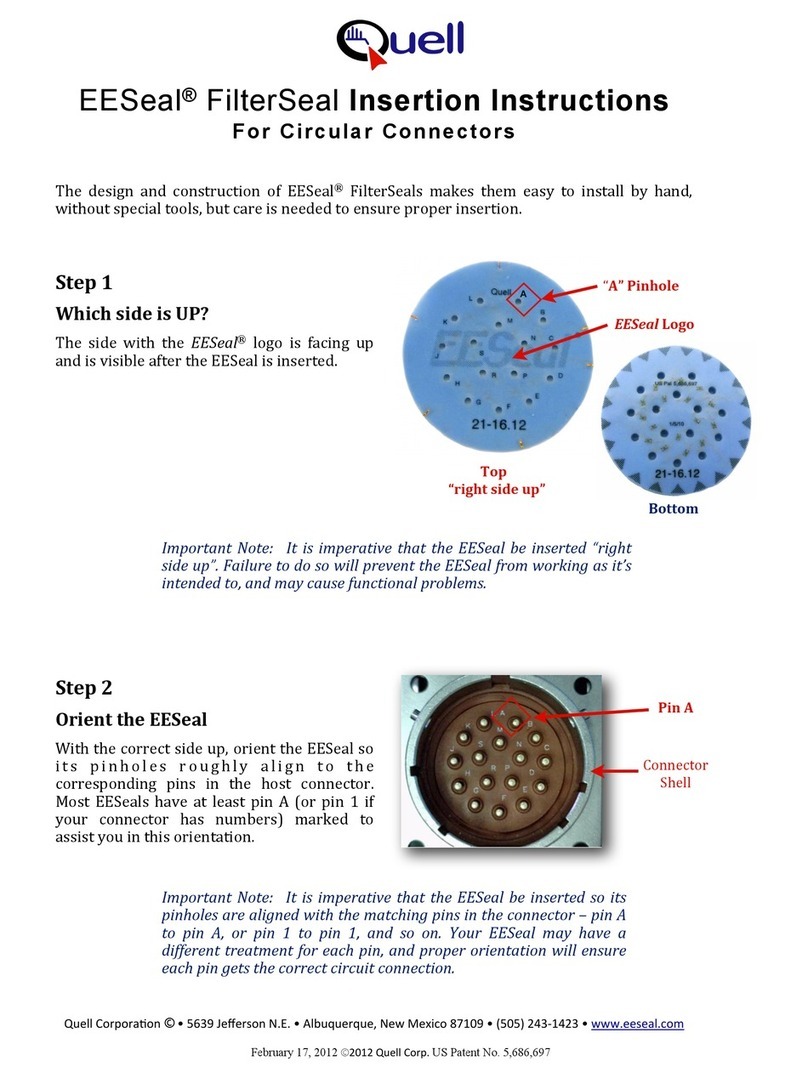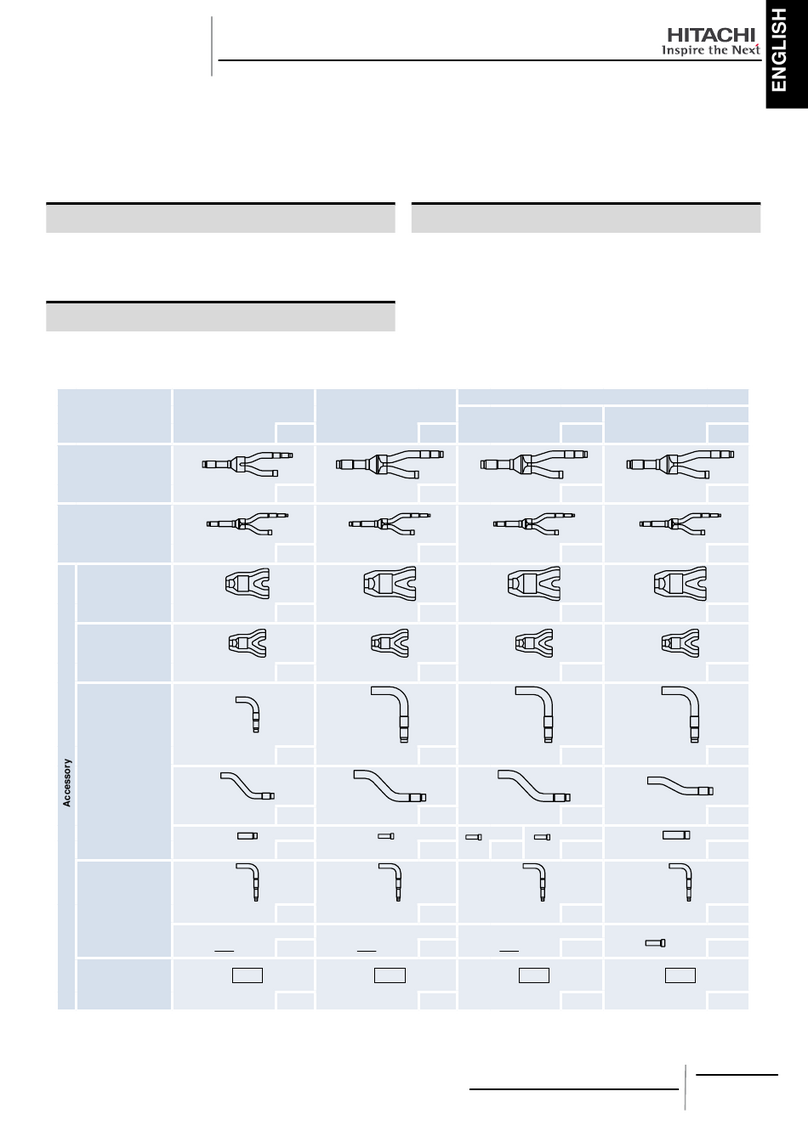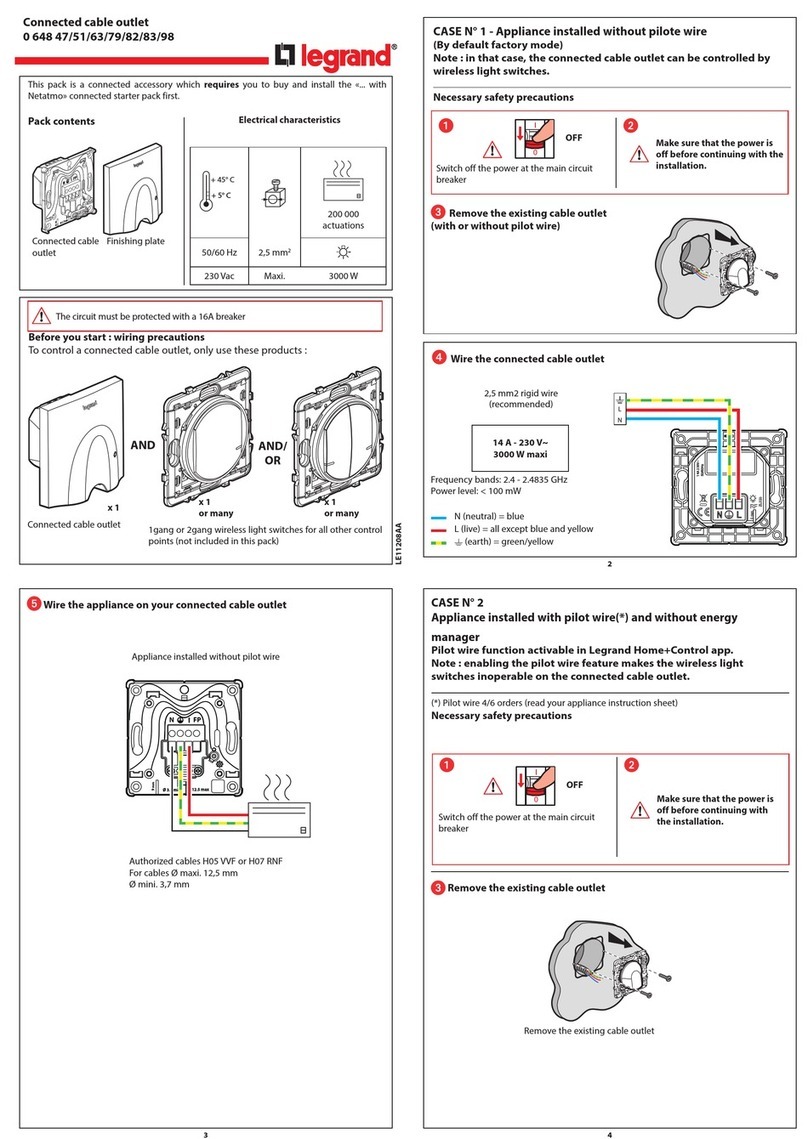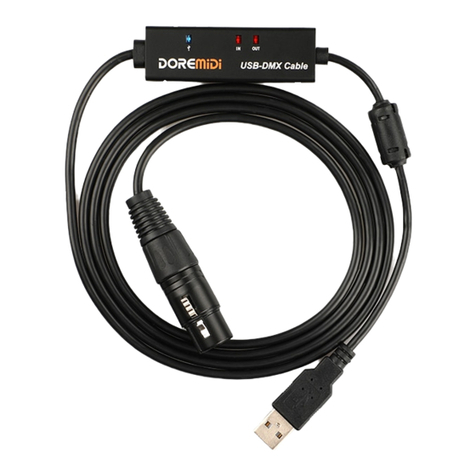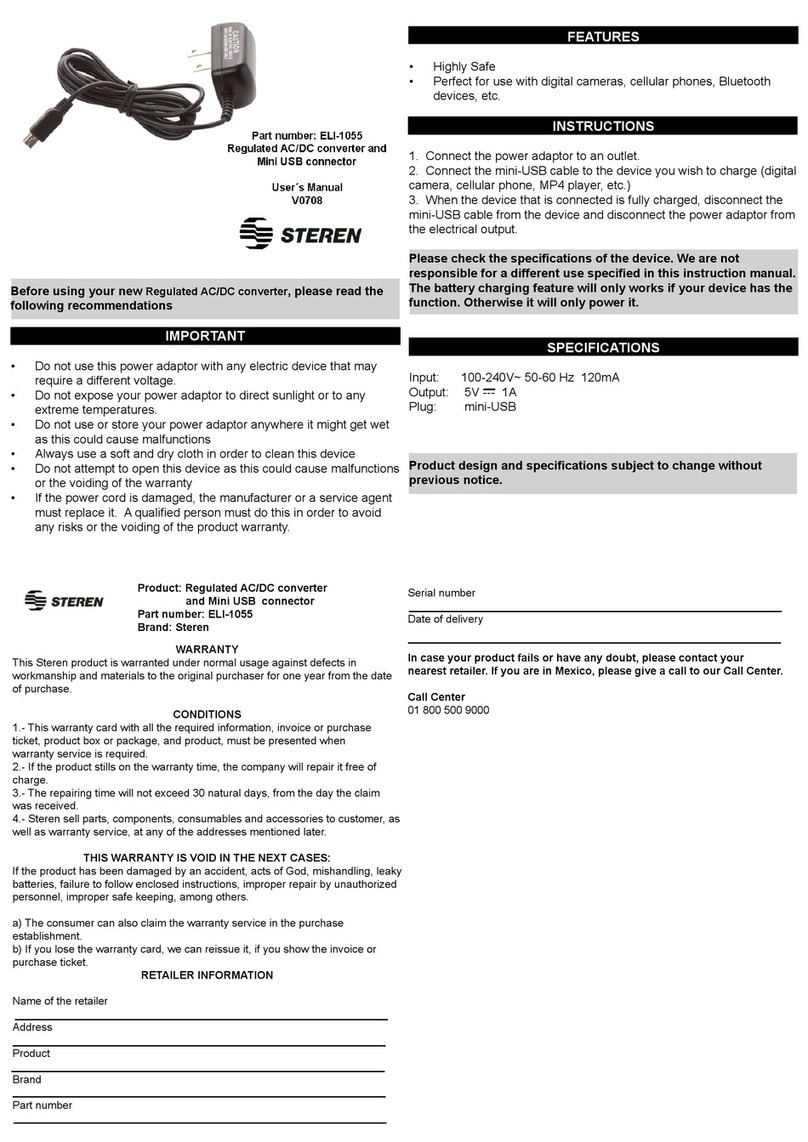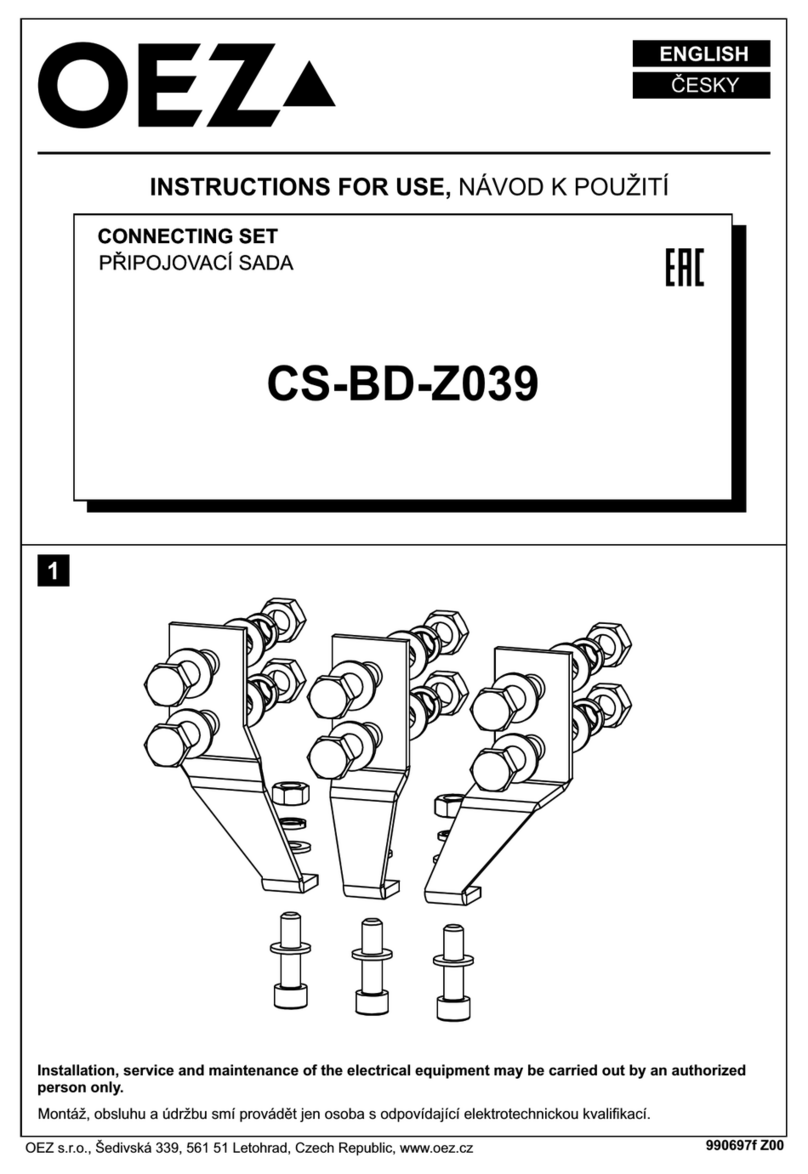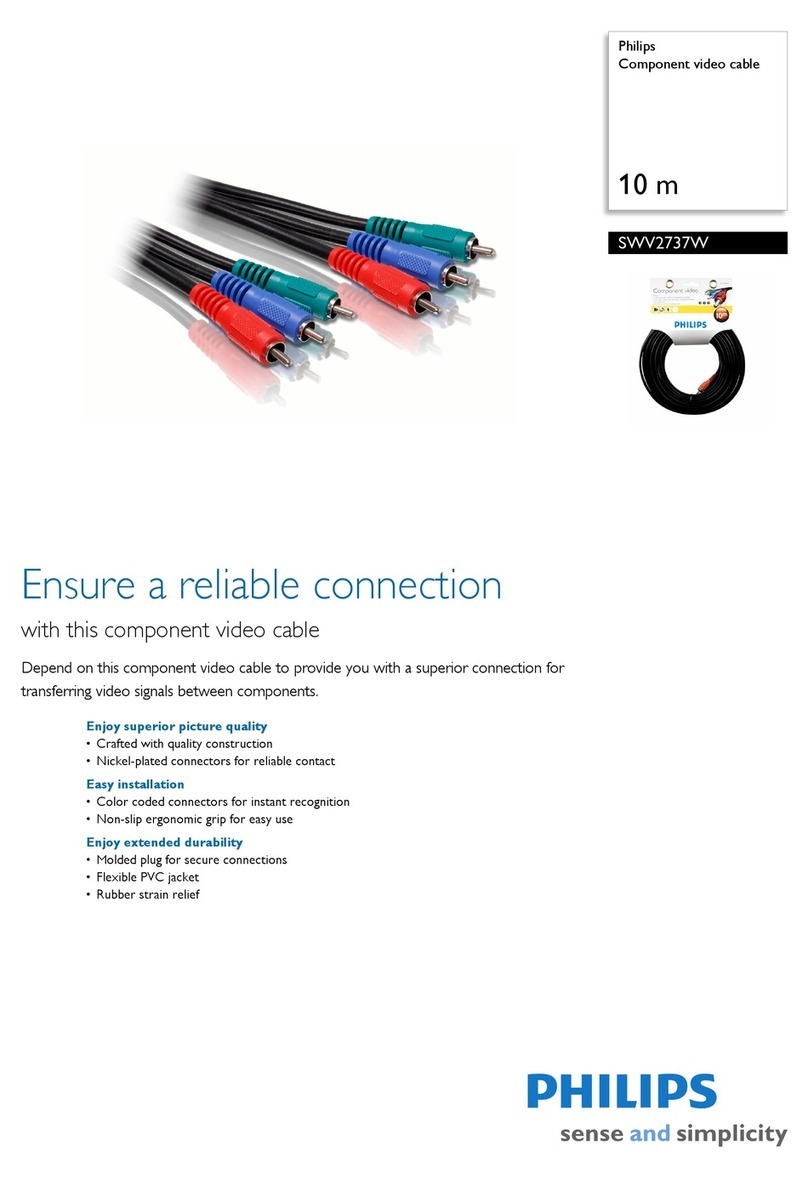Lindy 38041 User manual

© LINDY ELECTRONICS LIMITED & LINDY-ELEKTRONIK GMBH – SECOND EDITION (OCTOBER 2011)
16 Port HDMI Splitter
Manual English
LINDY No. 38041
www.lindy.com

Manual English
Introduction
Thank you for purchasing the LINDY 16 Port HDMI Splitter. This device is a high
performance 1.3 HDMI amplifier and video & audio splitter which allow one HDMI
source to be displayed simultaneously on 16 different displays. With extra features like
EDID this splitter is able to handle all your HDMI splitting needs.
Package Contents
•16 Port HDMI Splitter
•5V DC 6A PSU
•This manual
Features
•HDMI v1.3, HDCP 1.1 and DVI 1.0 compliant
•Supports HDTV resolutions: 480i, 576i, 480p, 576p, 720p, 1080i and 1080p
•Supports multi-channel audio when using a HDMI source and display(s)
•When used with computers, supports DVI-D resolutions up to UXGA (1920 x 1200)
•LPCM7.1CH, Dolby TrueHD, Dolby Digital Plus and DTS-HD Master Audio
transmission (32-192kHz Fs sample rate) supported
•Built in EDID simulator and HDCP keyset allows each output to work independently
when connecting to a HDMI display
•EDID functionality detects the EDID of the first port and records it to the splitter
•Supports both DVI-D source and display devices when using DVI-D/HDMI adapter
cables
•Cascadable – up to 3 splitters can be connected together for more displays
•Each input/output can support up to 10 metres
•xvYCC & 8/12 bit deep colour
•Up to 225Mhz bandwidth
•Chassis material: Powder coated metal
•Dimensions: WxDxH - 436 x 120 x 49mm (height with feet)
•Weight: 2.54kg total
•Warranty: 2yrs
Connections & Operation
Make sure all devices are switched off before making any connections. Once all the
connections have been made, switch on the devices in this order: displays, HDMI
Splitter, source device.
1. EDID Switch: Choose TV to allow the switch to use the EDID signal from the first
connected device. Choose STD to allow the switch to use the EDID signal recorded
1 2 3 4
Front

Manual English
Notes on using DVI
-
D
equipped devices:
To connect devices equipped with DVI-
D connections, you can use either modular DVI-D/HDMI adapters or DVI-D/HDMI
adapter cables. Be aware that DVI-D is a ‘video only’ interface; audio signals are not
supported when using DVI-D source devices. Also, please note that DVI-D equipped
displays must support HDCP signal decoding to display HDCP protected HDMI
signals. HDCP compatible displays will normally feature the HD Ready logo.
in the switch. The default setting is TV and should only be changed if you are
having any problems with your display
2. HDMI In: Connect your HD source device to this port
3. HDMI Out: Connect up to 16 HD displays to these ports
4. DC 5V: Connect the included 5V DC power supply to this port
1. Power LED: The LED will illuminate red when power is connected
2. Sync LED: The LED will blink when the power is first turned on and then illuminate
green when both the source and display are in sync
Connect the source device such as a DVD player or games console to the HDMI splitter’s
input port.
Connect the high definition displays to the HDMI splitter’s output ports.
When all the connections are made, connect the power supply and switch on.
1 2 Rear

CE/FCC &
Recycling Information
CE Certification
This equipment complies with the requirements relating to
further Standards cited therein.
FCC Certification
This equipment has been tested and found to comply with the limits for a Class B digital device, pursuant to part 15 of the F
Rules. These limits are designed to provide reasonable protection against harmful interference in a residential installation.
Y
ou are cautioned that changes or modification not expressly approved by the party responsible for compliance could void your
authority to operate the equipment.
This device complies with part 15 of the FCC Rules.
Operation is subject to the following two c
onditions:
1.
This device may not cause harmful interference, and
2.
This device must accept any interference received, including interference that may cause undesired operation.
WEEE (Waste of Electrical and Electronic Equipment),
Recycling of Electronic
United Kingdom
In 2006 the European Union introduced regulations (WEEE) for the collection and recycling of all waste electrical and electro
equipment. It is no longer allowable to simply throw away electrical and electronic equipment. Ins
enter the recycling process.
Each individual EU member state has implemented the WEEE regulations into national law in slightly different ways. Please
follow your national law when you want to dispose of any electrical or
your national WEEE recycling agency.
Germany
Die Europäische Union hat mit der WEEE Direktive umfassende Regelungen für die Verschrottung und das Recycling von
Elektro- und Elektronikprodukten gescha
ffen. Diese wurden von der Bundesregierung im Elektro
ElektroG in deutsches Recht umgesetzt. Dieses Gesetz verbietet vom 24.März 2006 an das Entsorgen von entsprechenden,
auch alten, Elektro-
und Elektronikgeräten über die Hau
örtlichen Sammelstellen zugeführt werden! Dort werden sie kostenlos entgegen genommen. Die Kosten für den weiteren
Recyclingprozess übernimmt die Gesamtheit der Gerätehersteller.
France
En
2006, l'union Européenne a introduit la nouvelle réglementation (DEEE) pour le recyclage de tout équipement électrique et
électronique.
Chaque Etat membre de l’ Union Européenne a mis en application la nouvelle réglementation DEEE de manières légèremen
différentes. Veuillez suivre le décret d’application correspondant à l’élimination des déchets électriques ou électroniques d
votre pays.
Italy
Nel 2006 l’unione europea ha introdotto regolamentazioni (WEEE) per la raccolta e il riciclo di apparecchi
Non è più consentito semplicemente gettare queste apparecchiature, devono essere riciclate. Ogni stato membro dell’ EU ha
tramutato le direttive WEEE in leggi statali in varie misure. Fare riferimento alle leggi del proprio Stato
apparecchio elettrico o elettronico.
Per ulteriori dettagli fare riferimento alla direttiva WEEE sul riciclaggio del proprio Stato.
Recycling Information
This equipment complies with the requirements relating to
Electromagnetic Compatibility
Standards
This equipment has been tested and found to comply with the limits for a Class B digital device, pursuant to part 15 of the F
Rules. These limits are designed to provide reasonable protection against harmful interference in a residential installation.
ou are cautioned that changes or modification not expressly approved by the party responsible for compliance could void your
This device complies with part 15 of the FCC Rules.
onditions:
This device may not cause harmful interference, and
This device must accept any interference received, including interference that may cause undesired operation.
WEEE (Waste of Electrical and Electronic Equipment),
Recycling of Electronic
Products
In 2006 the European Union introduced regulations (WEEE) for the collection and recycling of all waste electrical and electro
equipment. It is no longer allowable to simply throw away electrical and electronic equipment. Ins
Each individual EU member state has implemented the WEEE regulations into national law in slightly different ways. Please
follow your national law when you want to dispose of any electrical or
electronic products. More details can be obtained from
Die Europäische Union hat mit der WEEE Direktive umfassende Regelungen für die Verschrottung und das Recycling von
ffen. Diese wurden von der Bundesregierung im Elektro
-
ElektroG in deutsches Recht umgesetzt. Dieses Gesetz verbietet vom 24.März 2006 an das Entsorgen von entsprechenden,
und Elektronikgeräten über die Hau
smülltonne! Diese Geräte müssen den lokalen Sammelsystemen bzw.
örtlichen Sammelstellen zugeführt werden! Dort werden sie kostenlos entgegen genommen. Die Kosten für den weiteren
Recyclingprozess übernimmt die Gesamtheit der Gerätehersteller.
2006, l'union Européenne a introduit la nouvelle réglementation (DEEE) pour le recyclage de tout équipement électrique et
Chaque Etat membre de l’ Union Européenne a mis en application la nouvelle réglementation DEEE de manières légèremen
différentes. Veuillez suivre le décret d’application correspondant à l’élimination des déchets électriques ou électroniques d
Nel 2006 l’unione europea ha introdotto regolamentazioni (WEEE) per la raccolta e il riciclo di apparecchi
Non è più consentito semplicemente gettare queste apparecchiature, devono essere riciclate. Ogni stato membro dell’ EU ha
tramutato le direttive WEEE in leggi statali in varie misure. Fare riferimento alle leggi del proprio Stato
Per ulteriori dettagli fare riferimento alla direttiva WEEE sul riciclaggio del proprio Stato.
2nd
Standards
EN55022/EN55024 and the
This equipment has been tested and found to comply with the limits for a Class B digital device, pursuant to part 15 of the F
CC
Rules. These limits are designed to provide reasonable protection against harmful interference in a residential installation.
ou are cautioned that changes or modification not expressly approved by the party responsible for compliance could void your
This device must accept any interference received, including interference that may cause undesired operation.
In 2006 the European Union introduced regulations (WEEE) for the collection and recycling of all waste electrical and electro
nic
equipment. It is no longer allowable to simply throw away electrical and electronic equipment. Ins
tead, these products must
Each individual EU member state has implemented the WEEE regulations into national law in slightly different ways. Please
electronic products. More details can be obtained from
Die Europäische Union hat mit der WEEE Direktive umfassende Regelungen für die Verschrottung und das Recycling von
-
und Elektronikgerätegesetz –
ElektroG in deutsches Recht umgesetzt. Dieses Gesetz verbietet vom 24.März 2006 an das Entsorgen von entsprechenden,
smülltonne! Diese Geräte müssen den lokalen Sammelsystemen bzw.
örtlichen Sammelstellen zugeführt werden! Dort werden sie kostenlos entgegen genommen. Die Kosten für den weiteren
2006, l'union Européenne a introduit la nouvelle réglementation (DEEE) pour le recyclage de tout équipement électrique et
Chaque Etat membre de l’ Union Européenne a mis en application la nouvelle réglementation DEEE de manières légèremen
t
différentes. Veuillez suivre le décret d’application correspondant à l’élimination des déchets électriques ou électroniques d
e
Nel 2006 l’unione europea ha introdotto regolamentazioni (WEEE) per la raccolta e il riciclo di apparecchi
elettrici ed elettronici.
Non è più consentito semplicemente gettare queste apparecchiature, devono essere riciclate. Ogni stato membro dell’ EU ha
tramutato le direttive WEEE in leggi statali in varie misure. Fare riferimento alle leggi del proprio Stato
quando si dispone di un
LINDY No. 38041
2nd
Edition October 2011
www.lindy.com
Table of contents
Other Lindy Cables And Connectors manuals

